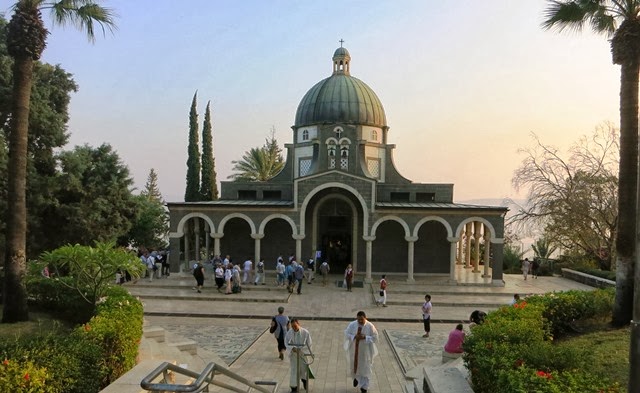I’ve not heard the Israeli side of the story but it clear that the Wall is an abomination that should not be necessary or exist in a civilised society. There is a lot of graffiti on the Palestinian side of the Wall and we viewed a beautiful mural of the Madonna painted on it by an English iconographer now living in Palestine. Then we prayed that peace would come to this suffering land.
For the
next three hours our little coach headed north on the highway towards Galilee. Soon
we had left the desert behind, the shrivelled trees and stunted scrubs were replaced
by flowering bougainvillaea that grew for miles at the roadside. Large
cultivated fields appeared, the number of trees multiplied and the style of housing
changed, becoming more European, with colourful roof tiles and well-kept
gardens. There were gleaming modern buildings, high-rise housing, motorway service
stations. In short, the north of Israel seemed vastly more fertile and more Westernised
than the south.
Galilee
was a delight, the hills and the Sea of Galilee reminded me strongly of the
Lake District in England or the Scottish Highlands.
We
stopped first at the small Franciscan Church of Peter’s Primacy, built of the
black basalt rock of the region (rather than the pale limestone rock of the
south of Israel), set on the shore of the Sea of Galilee and surrounded by peaceful
gardens.
It was in one of these gardens that Frs. Mark and Ephraim co-celebrated
Mass, a simple and moving occasion. Afterwards we wandered about thinking of
the occasions when Jesus visited this place, or one just like it: preaching
from a boat just off the shore; telling the Apostles to try their net on the other
side of the boat; and asking Peter three times if he loved Him.
Inside the
church, in the sanctuary, there is a rock where tradition holds that Jesus cooked
the fish for the Apostles just after His Resurrection. When we visited there
was a large and devout party of green-tracksuited pilgrims from Nigeria visiting
the church, as well as a large group of Orthodox Russian nuns in severe black veils
and headdresses. Later, we met other pilgrim parties from China, Korea,
Germany, Poland, the UK, and the Philippines.
Then it
was on to the town of Capernaum where Simon Peter lived – and also where Jesus
lived after he left Nazareth. For me, the highlight was the excavated ruins of
Peter’s house. Yes, archaeologists are convinced that this is really the house belonging to Simon Peter’s mother in law where Saint Peter actually lived two thousand years ago. An octagonal church has been raised above the remains and it has a glass floor so that they can be easily viewed. The word ‘awesome’ does not even begin to describe the significance of this memorial of the Apostle’s life.
To add to the riches of this place, there is a small excavated village of first-century houses and a fourth century synagogue that was built over the ruins of a first-century synagogue and part of the black stone flooring of this earlier synagogue has been exposed.
This is literally a synagogue of the time of Christ in a town where he is known to have lived and where it is very reasonable to suppose that he visited!
Lunch was at a seaside restaurant where the speciality was a local fish (called ‘Peter’s fish’ naturally), a talipa if I recall correctly, deep fried and served whole with some potatoes (US$15 including buffet salad). It was very tasty.
Tabgha
is one of the most important sites of Jesus’ ministry in Galilee, He did much
of His preaching here. We visited the Church of the Multiplication of the
Loaves and the Fishes, commemorating when Jesus fed 5,000 followers with five
loaves and two fish.
On the altar is a rock where Jesus is said to have placed
the fish and loaves at the time of performing the miracle.
Outside
in the courtyard is a first century wine press and an olive press of the same
age.
On top
of the hill behind – called the Mount of the Beatitudes – is the Church of the
Beatitudes that commemorates Jesus’s Sermon on the Mount.Its setting is beautiful, tranquil, and the church is surrounded by extensive landscaped gardens, with a variety of plants, trees and bougainvillaea. What remains in my mind is the natural beauty of the place – and the birdsong. It seemed every bird in Galilee was singing when we visited, it was still warm, the sun was beginning to set, the Sea of Galilee was spread out before us, the water calm, the distant hills hazy. Below, in a natural amphitheatre, a Mass was in process and the Polish congregation was singing a joyful hymn.
It was
twilight when we reached the harbour at Tiberias.
Our boat was waiting and the
Israeli crew, no slouches at trying to extract tips, made a point of exchanging
the Stars and Stripes for the Union Jack and playing a recording of God Save the Queen.
We slowly chugged
out into the lake, watching the lights of Tiberias recede, the sound of faint singing
coming from the shore. After 15 minute the engine was stopped, the deck lights
extinguished and Fr. Mark read from St Matthews Gospel the story of how Jesus calmed
the storm.


.jpg)










No comments:
Post a Comment